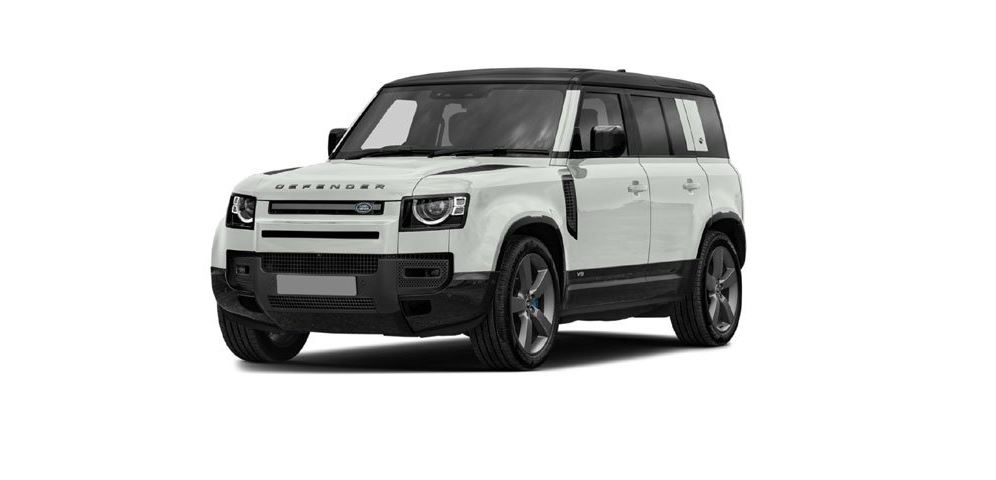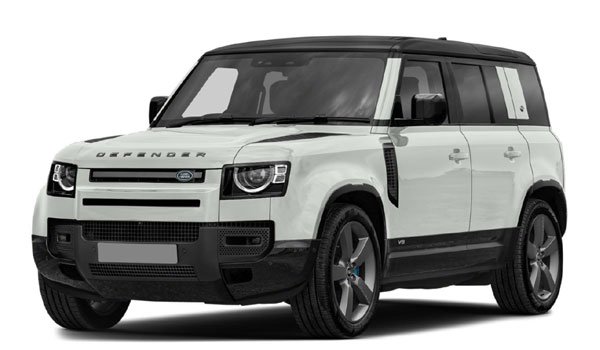 2023 Land Rover Defender Fuel and Refueling
2023 Land Rover Defender Fuel and Refueling
SAFETY PRECAUTIONS
Make sure that the following warnings have been read and understood. Failure to observe the warnings could result in an accident, leading to serious injury or death.
- Do not smoke, use an exposed flame, or cause sparks while refueling.
- Avoid exposing the fuel gases to any potential sources of ignition.
- Switch off the engine when refueling, as it is both a source of extreme temperatures and electrical sparks.
- When refueling, switch off any personal electronic devices such as mobile phones or music players.
- Take note of all warnings and instructions given on the label affixed to the inside of the fuel filler flap.
- The fuel system is designed to make sure that spillage does not occur. Do not attempt to fill the tank past its maximum capacity.
- Make sure that the fuel filler nozzle is fully inserted into the filler neck. If the nozzle is inserted loosely, fuel spillage may occur.
- When refueling, make sure that all of the windows, doors, and panoramic roof are fully closed. Use extreme care and caution if young children or animals are in the vehicle.
- Only use containers specifically designed for carrying fuel, and always remove them from the vehicle to fill them.
PETROL ENGINED VEHICLES
Use high-quality fuel with a detergent that meets the specification defined by EN228, WWFC5 cat. 5, or the national equivalent. Low-quality fuel can damage the engine and reduce engine performance.
Do not use leaded fuels, fuels with lead substitutes, e.g., manganese-based, or fuel additives. The vehicle’s emission control systems can be adversely affected, which may affect the vehicle’s warranty coverage.
Fuel system cleaning agents should not be used, unless approved by the vehicle manufacturer. Inadequate cleaning agents may damage the fuel system.
OCTANE RATING
Do not use fuels with an octane rating lower than 91 RON, as severe engine damage may occur.
Do not use leaded fuels, fuels with lead substitutes, e.g., manganese-based or fuel additives. Doing so may adversely affect the vehicle’s emission control systems and affect the vehicle’s warranty.
The vehicle manufacturer recommends the use of premium unleaded fuel with a minimum octane rating of 95 RON. Using the correct fuel specification helps to maintain the vehicle’s performance, fuel economy, and driveability.
If premium unleaded fuel is not available, use unleaded fuel with a lower octane rating, down to a minimum of 91 RON. Using lower octane-rated fuel may reduce the engine’s performance, increase fuel consumption, cause an audible engine knock, and cause other driveability problems.
Consult a retailer/authorized repairer if an engine knock is detected while holding a steady speed on level roads. Also consult a retailer/authorized repairer if a heavy persistent engine knock is detected, even if using fuel to the recommended octane rating. Failure to do so is a misuse of the vehicle, which is not covered by the vehicle’s warranty.
An occasional, light engine knock when accelerating or climbing hills is acceptable.
Super Green Plus 98 RON unleaded fuel, where available, may be used as an alternative to the standard 95 RON unleaded fuel.
ETHANOL
Do not use fuels containing more than 10% ethanol. Higher ethanol content can damage the vehicle’s engine and fuel system.
Do not use E85 fuels with 85% ethanol content, as serious engine and fuel system damage can occur.
Fuels containing up to 10% ethanol may be used, e.g., E5 and E10.
Make sure that the fuel has octane ratings no lower than those recommended for unleaded fuel. Correct engine operation should not be affected with fuel containing the permissible amount of ethanol. If a difference is detected, the use of conventional unleaded fuel should be resumed.
METHANOL
Wherever possible, avoid using fuel containing methanol. Using fuel containing methanol may cause serious engine and fuel system damage, which is not covered by the vehicle’s warranty.
METHYL TERTIARY BUTYL ETHER (MTBE)
Unleaded fuel containing an oxygenate known as Methyl Tertiary Butyl Ether (MTBE) can be used. The ratio of MTBE to conventional fuel must not exceed 15%. MTBE is an ether-based compound derived from petroleum. MTBE has been specified by several refiners as a substance to enhance the octane rating of fuel.
DIESEL ENGINED VEHICLES
If the fuel tank is inadvertently filled with petrol instead of diesel, do not attempt to start the engine. In this event, contact a retailer/authorized repairer immediately. Inadequate fuels may damage the fuel system and engine components.
Any damage caused by running the vehicle with fuel other than that stipulated is not covered under the warranty.
If a diesel engine is difficult to start in extremely cold temperatures of -15°C or less, consult a retailer/authorized repairer for assistance.
Use only high-quality diesel fuel, according to the European standard EN590:2013+A1:2017, WWFC 5 cat. 5 or equivalent.
Fuels containing a blend of up to 7% bio-diesel may be used, in accordance with the European standard EN590:2013+A1:2017. Using a higher blend of biodiesel is not recommended. Inadequate fuels may damage the fuel system and engine components, or premature fuel filter blockage may occur.
Malaysia only: Fuels containing a blend of up to 30% bio-diesel may be used.
The quality and specification of diesel fuel vary significantly, depending on geographical location. Using premium fuel is recommended, or the highest quality of fuel available. High-quality fuel promotes a longer life for the engine’s components.
Lower grade fuel contains higher levels of sulfur, which is detrimental to the engine’s components. If low-quality fuel is used, light-colored smoke may be evident at the exhaust.
Prolonged use of additives is not recommended. Do not add paraffin or petrol to diesel fuels.
AUXILIARY HEATER
Do not operate the auxiliary heater when refueling the vehicle. Doing so may cause fuel vapors to combust, potentially causing a fire or explosion.
The auxiliary heater is powered by fuel drawn from the vehicle’s tank and operates at low ambient temperatures, helping to boost the temperature of the engine’s coolant. See AUXILIARY HEATER.
SULPHUR CONTENT
Using an incorrect specification of fuel causes serious damage to the engine and the exhaust after-treatment system. The vehicle’s warranty does not cover this. If in doubt, contact a retailer or authorized repairer for advice.
The maximum sulfur content of the diesel fuel must not exceed the level shown in the table below. The sulfur content is in compliance with the EN590-EU4 and World Wide Fuel Charter (WWFC Category 3 or above) standards. Failure to comply with the standards may damage engine components and the exhaust after-treatment system.
| Vehicle emission level | Maximum sulfur content % (parts per million) |
|---|---|
| EU6 | 0.0015 (15) |
| EU5 and lower | 0.005 (50) |
If in doubt regarding the emissions level of the vehicle, contact a retailer or authorized repairer for advice.
DIESEL EXHAUST FLUID (DEF)
DEF must be kept out of children’s reach, to avoid serious injury or death.
Read the label for safety precautions when using DEF, to avoid injury.
DEF must be stored in the original container, in a cool, dry, and well-ventilated area. Observe the manufacturer’s storage and handling recommendations. If inappropriately stored, DEF may spill or be exposed to contamination.
DEF has a strong odor and can stain clothing or upholstery. Take care not to spill the fluid when performing a top-up procedure. In the event of spillage, rinse immediately with clean water.
When refilling, make sure that the correct specification of DEF is used. Use of the incorrect fluid can result in serious damage to the vehicle. In this situation, do not start the engine, contact a retailer/authorized repairer immediately.
Vehicles with a diesel engine may have a tank containing Diesel Exhaust Fluid (DEF). DEF is used to make sure that correct exhaust emissions are achieved. DEF is also known as AdBlue™, AUS 32, and ARLA 32. AdBlue™ is a trademark of the Verband der Automobilindustrie e.V. (VDA).
Dependent on the current geographical location, correct use of the DEF system may be a legal requirement. Running the vehicle without the correct specification of DEF may be a criminal offense. Always use the correct DEF specification, and the correct quantity of DEF. See LUBRICANTS AND FLUIDS and CAPACITIES.
The consumption of DEF can vary greatly. An average consumption rate can be 800 km (500 miles) / 1 L. However, this consumption rate can be more than doubled, depending on driving style, and road and weather conditions.
The distance until the DEF tank is empty and the volume of DEF required for refill is displayed via the Touchscreen:
- Touch the settings icon¹ from any screen.
- Touch the ALL soft key.
- Touch the Vehicle’s soft key.
- Touch the Service soft key.
- The DEF range and refill volume is displayed.
- Touch the exit icon² to return to the previously displayed screen.
The instrument panel displays a series of messages when the DEF level becomes low. The volume of DEF required for refill also accompanies each message:
- The first message is accompanied by a white warning icon, indicating low DEF level, and the distance remaining until the DEF tank is empty.
- The second message is accompanied by a yellow warning icon, indicating low DEF level, and the distance remaining until the DEF tank is empty.
- The third message is accompanied by a yellow warning icon, and starts a countdown of the distance remaining until the DEF tank is empty. After the countdown, vehicle start is inhibited.
- The final message is accompanied by a red warning icon and is displayed when the distance remaining is zero. The message states that no further restarts are possible until DEF is added to the tank.
When the DEF level becomes low, a notification displays in the instrument panel. Refill the DEF tank at the earliest opportunity.
The volume of DEF required to top up or restart the engine is displayed in the instrument panel. Refill bottles are available from a retailer/authorized repairer.
To perform a DEF top-up procedure, locate the DEF tank. See FLUID FILLER LOCATIONS. Then, follow the steps below:
- Turn the tank filler cap counter-clockwise to remove.
- Making sure not to exceed the required volume, top up the tank following the instructions given on the DEF container.
NOTES
Non-drip bottles are the recommended method for top-up. - Replace the tank filler cap and continually turn clockwise until hand tight.
If a DEF warning lamp, or message illuminates with a red warning icon, seek qualified assistance at the earliest opportunity. The possible events for this include DEF system malfunctions, incorrect fluid, and poor fluid quality. See DIESEL EXHAUST FLUID (DEF) (RED) and DIESEL EXHAUST FLUID (DEF) (YELLOW).
In extremely low temperatures below -10°C, DEF may freeze in the tank, making refilling difficult. Move the vehicle into a warmer environment, e.g., a garage. Raise the ambient temperature, in order to thaw the DEF, before attempting to top up. In these conditions, it may take up to 1 hour of driving before the low DEF message extinguishes.
When starting and stopping the engine, operation of the DEF pumps may be heard, but this is no cause for concern.
Settings icon.¹
Exit icon.²
RUNNING OUT OF FUEL
Avoid running out of fuel. Doing so can cause damage to the vehicle’s engine, fuel, and emission control systems.
If the vehicle does run out of fuel, seeking qualified assistance is advisable.
If the vehicle does run out of fuel, a minimum of 4.0 L is required to restart the engine. See FUEL FILLER FLAP.
The vehicle should be left with the ignition switched on for 5 minutes after refueling, before attempting to restart the engine. The vehicle needs to be driven for a distance of 1.5 to 5 km in order to reset the engine management and monitoring systems.
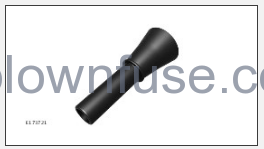
Vehicles with a diesel engine may be supplied with an active misfuelling device. A metal flap is visible in the filler neck when the fuel filler cap is removed. Use the emergency funnel supplied with the vehicle to refill the fuel tank with a fuel can. Insert the funnel into the filler neck, fully and squarely, to open the active misfuelling device. See ACTIVE DIESEL MISFUELLING PROTECTION DEVICE.
Misfuelling devices are dependent on the market specification.
WATER IN FUEL
If the instrument panel displays a warning message, an excessive amount of water has collected in the fuel system. In this event, consult a retailer/authorized repairer as soon as possible. Water in fuel can damage engine components or the fuel system.
DIESEL ENGINES
Running out of fuel draws air into the fuel system and may cause serious damage to the fuel injection system. In this event, seek qualified assistance immediately.
If the fuel gauge indicates a low fuel level, or the low fuel warning lamp illuminates, refuel the vehicle as soon as possible. Refuel the vehicle with at least 4 L of fuel.
After refueling, restart the vehicle using the following procedure:
- With the brake pedal pressed, press and hold the engine START/STOP button and crank the engine for 5 seconds.
- Release the START/STOP button.
- With the brake pedal pressed, press and release the START/STOP button to crank the engine. The engine should start within approximately 5 seconds.
If the engine does not start, leave the vehicle’s ignition switched on for 10 seconds, then repeat the complete procedure.
Do not crank the engine for longer than 30 seconds continuously. Doing so may cause damage to the vehicle’s engine.
FUEL FILLER FLAP
Make sure the relevant safety warnings have been read and understood before refueling the vehicle. See SAFETY PRECAUTIONS.
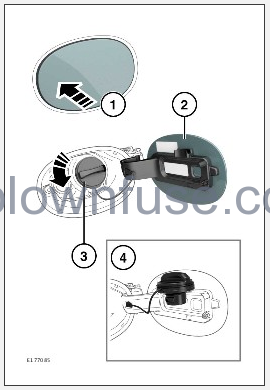
The fuel filler flap is located on the right side of the vehicle, at the rear. To operate, proceed as follows:
- Press and release the rear of the fuel filler flap to unlatch.
- Pull the flap open. The label on the inside of the flap indicates the correct fuel for the vehicle.
- Turn the filler cap counter-clockwise to undo.
- Use the securing clip to keep the filler cap out of the way while fuelling.
When replacing the filler cap, turn it clockwise until the ratchet clicks.
To close the filler flap, push the flap until it is securely latched.
Plug-in Hybrid Electric Vehicles (PHEV) incorporate a locking fuel filler flap. See FUEL FILLER FLAP LOCK (PHEV).
FUEL FILLER FLAP LOCK (PHEV)
Make sure that the vehicle is refueled shortly after the refueling button is pressed. Failure to do so may result in the fuel tank not being filled to the required level. If in doubt, check the fuel level gauge in the instrument panel before continuing the journey, to prevent running out of fuel.
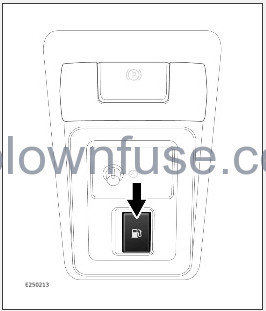
To enable refueling, carry out the following:
- Switch off the vehicle’s ignition, apply the Electric Parking Brake (EPB), and make sure that the transmission is engaged in Park (P).
- Press the refueling button located in the lower switch panel at the driver’s side of the fascia. The isolation valve on the fuel tank opens to equalize the fuel tank pressure. The fuel filler flap unlocks. The instrument panel displays a message to confirm that the fuel filler flap is unlocking.
- The instrument panel displays a message to confirm that the fuel filler flap is unlocked and the vehicle can be refueled. See FUEL FILLER FLAP.
The isolation valve on the fuel tank remains open for approximately 10 minutes, at which point the valve shuts, preventing further refueling. If further refueling is required, repeat the above process from step 2 to open the isolation valve on the fuel tank.
Make sure that the vehicle is stationary. The fuel filler flap does not unlock, and the isolation valve on the fuel tank does not open, if the vehicle is moving. The instrument panel displays a message to confirm that the vehicle’s speed is too high.
If a fault is detected on either the fuel filler flap system, or on the isolation valve system on the fuel tank, the instrument panel displays a message. In this event, consult a retailer/authorized repairer or roadside assistance. See ROADSIDE ASSISTANCE. See INCONTROL REMOTE SMARTPHONE APP.
FUEL FILLER
Make sure the relevant safety warnings have been read and understood before refueling the vehicle. See SAFETY PRECAUTIONS.
Check the fuel pump information carefully to make sure that the correct fuel is used to refuel the vehicle. Inadequate fuel can reduce engine performance and may cause permanent damage to engine components.
If the vehicle is filled with the incorrect fuel, it is essential to seek qualified assistance before starting the engine. Inadequate fuel can reduce engine performance and may cause permanent damage to engine components.
Filling station pumps are equipped with automatic cut-off sensing, to avoid fuel spillage. Fill the tank until the filler nozzle automatically cuts off the supply. Do not attempt to fill the tank beyond this point.
The filling station pumps used for commercial vehicles deliver fuel at a higher rate than normal. The higher fill rate can cause premature cut-off and may cause fuel spillage. Only the use of standard light vehicle fuel pumps is recommended.
IDENTIFICATION OF CORRECT FUEL
The vehicle’s fuel label displays information about the correct type and specification of fuel. The label is located on the fuel filler flap and may display the following:
Refuel only from the fuel pump displaying a similar label to that fitted on the vehicle.
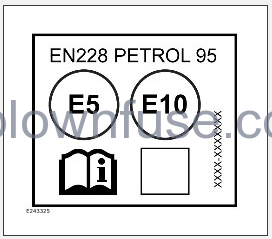
The above label identifies that unleaded petrol, meeting specification EN228, with a maximum ethanol content of 5% or 10% may be used.
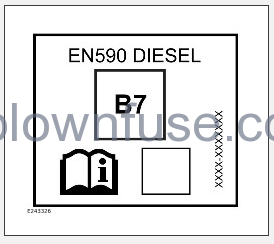
The above label identifies that diesel fuel, meeting specification EN590, with a maximum bio-diesel content of 7% may be used.
ACTIVE DIESEL MISFUELLING PROTECTION DEVICE
Do not force an incorrectly sized fuel pump nozzle into the filler neck. Forcing an incorrectly sized fuel pump nozzle into the filler neck may result in damage to the vehicle.
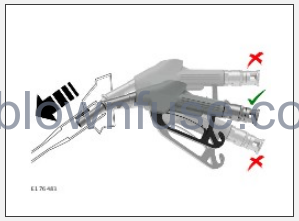
Vehicles with a diesel engine may have an active misfuelling protection device. A metal flap is visible in the filler neck when the fuel filler cap is removed. The active misfuelling protection device helps to prevent the fuel tank from being filled with the incorrect fuel, e.g., petrol. Refueling is permitted if a correctly sized, diesel fuel pump’s filler nozzle is inserted, fully and squarely, into the vehicle’s fuel filler neck, as illustrated.
To refuel with a fuel can, use the emergency funnel supplied with the vehicle. See RUNNING OUT OF FUEL.
Misfuelling devices are dependent on the market specification.
FUEL TANK CAPACITY
Avoid the risk of running out of fuel. Never intentionally drive the vehicle when the fuel gauge indicates that the fuel tank is empty. When refueling the vehicle after the indicated range reads zero, it may not be possible to add the maximum fuel quantity. The fuel tank retains a small reserve of fuel. See CAPACITIES.
FUEL CONSUMPTION
Observe the following to improve fuel consumption and reduce CO₂ emissions:
- Use the vehicle correctly.
- Make sure the vehicle is regularly maintained.
- Travel at lower speeds.
- Avoid aggressive driving.
- Correctly inflate the tires.
- Reduce engine idling periods.
- Avoid carrying excessive weight.
